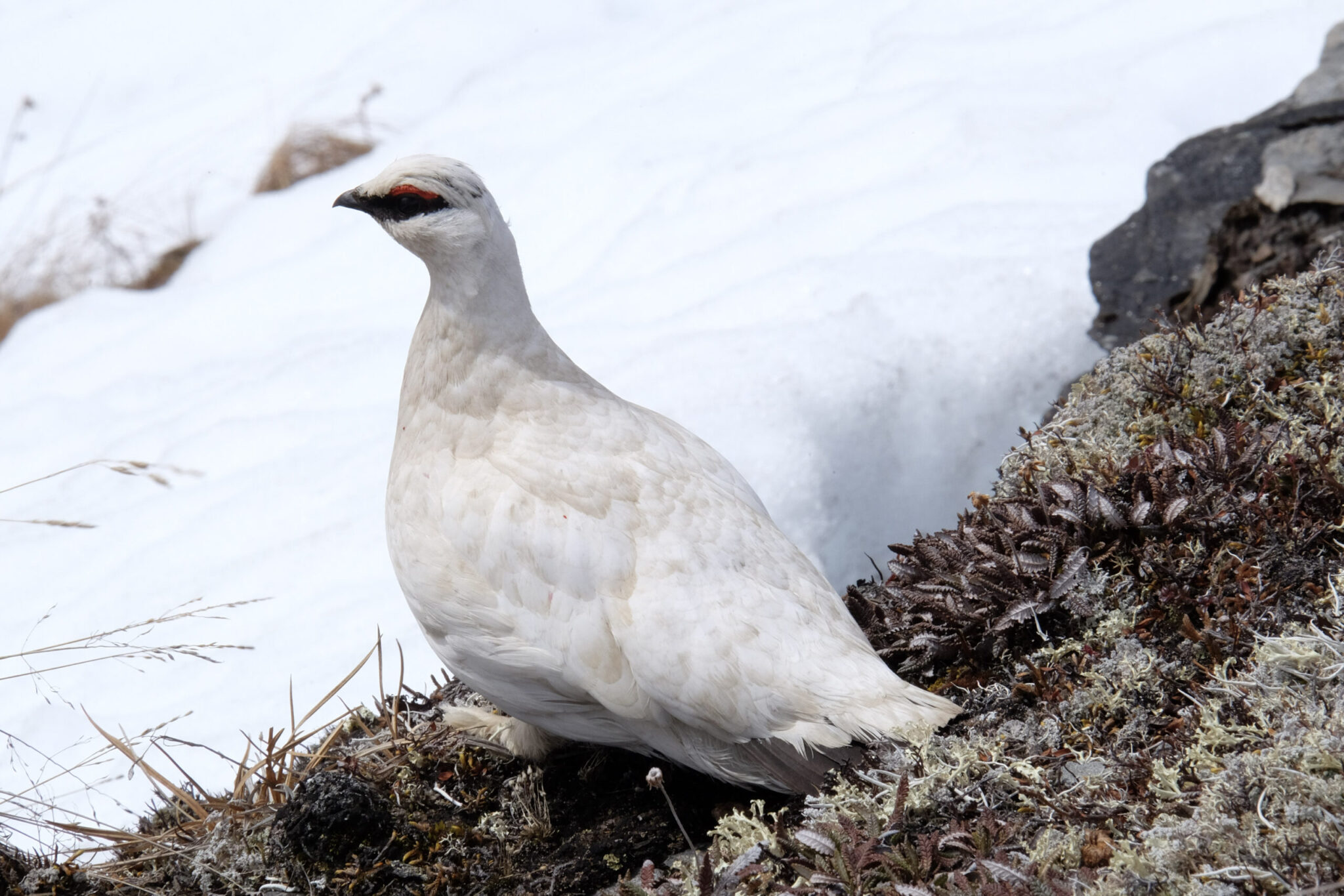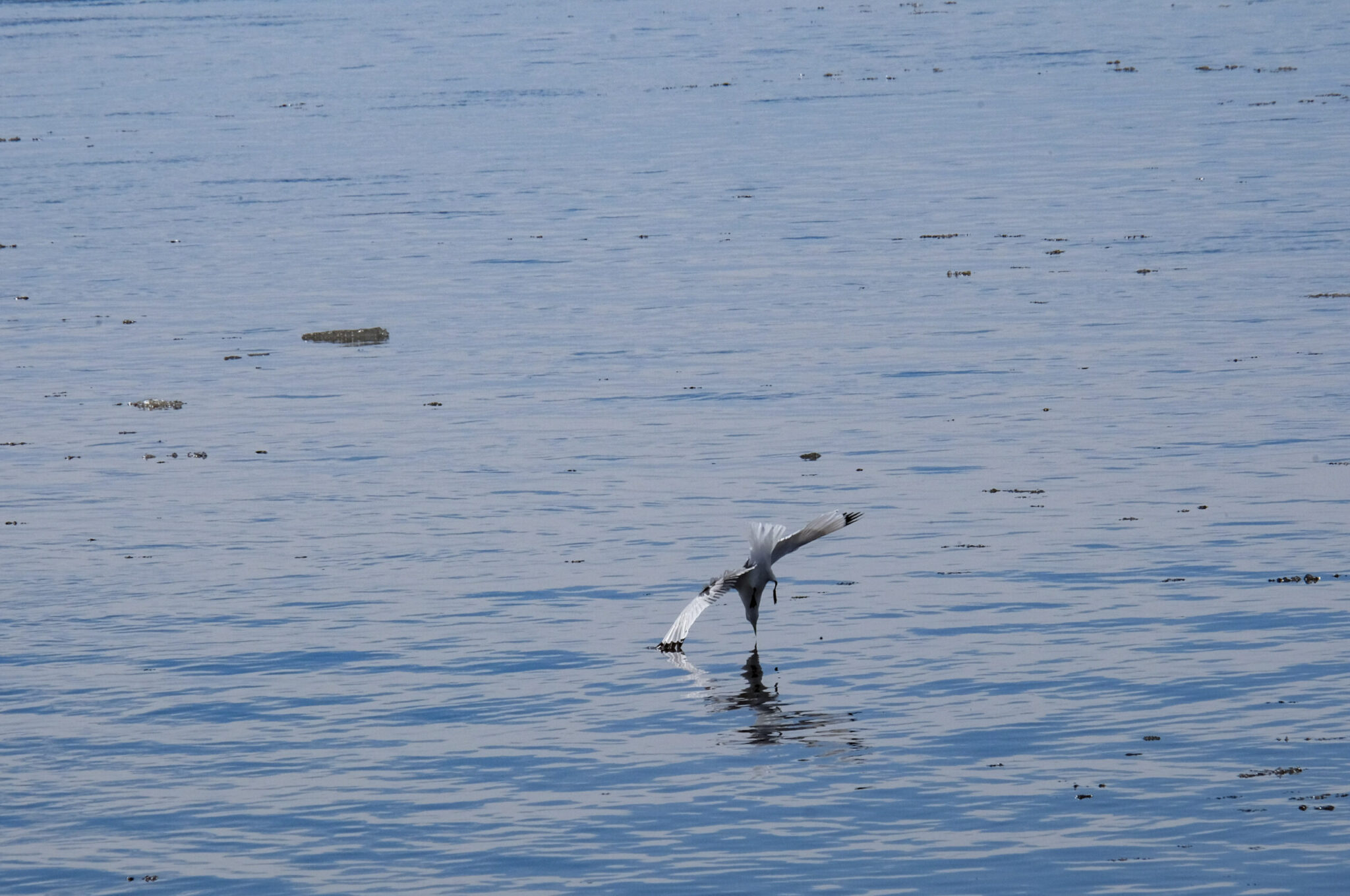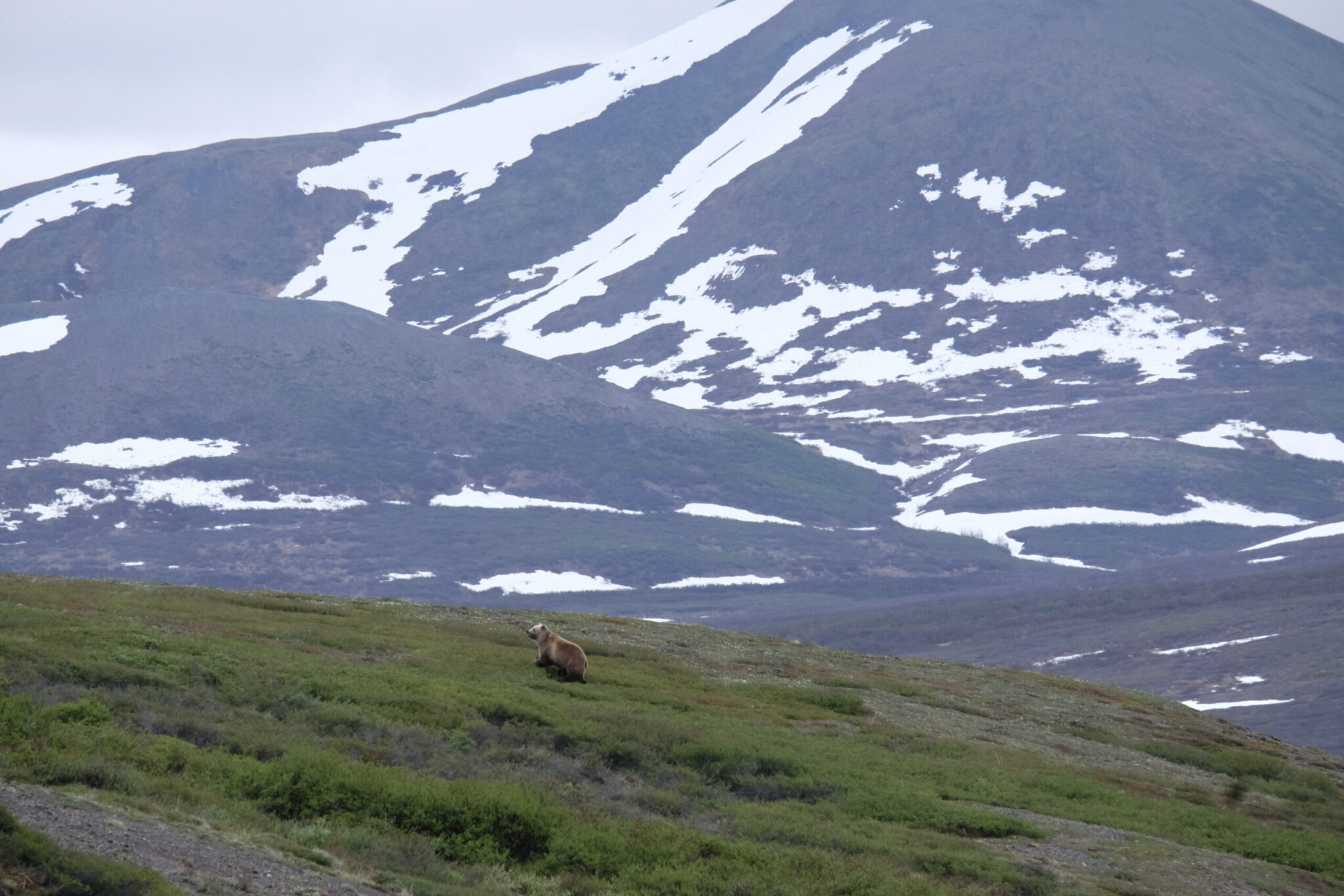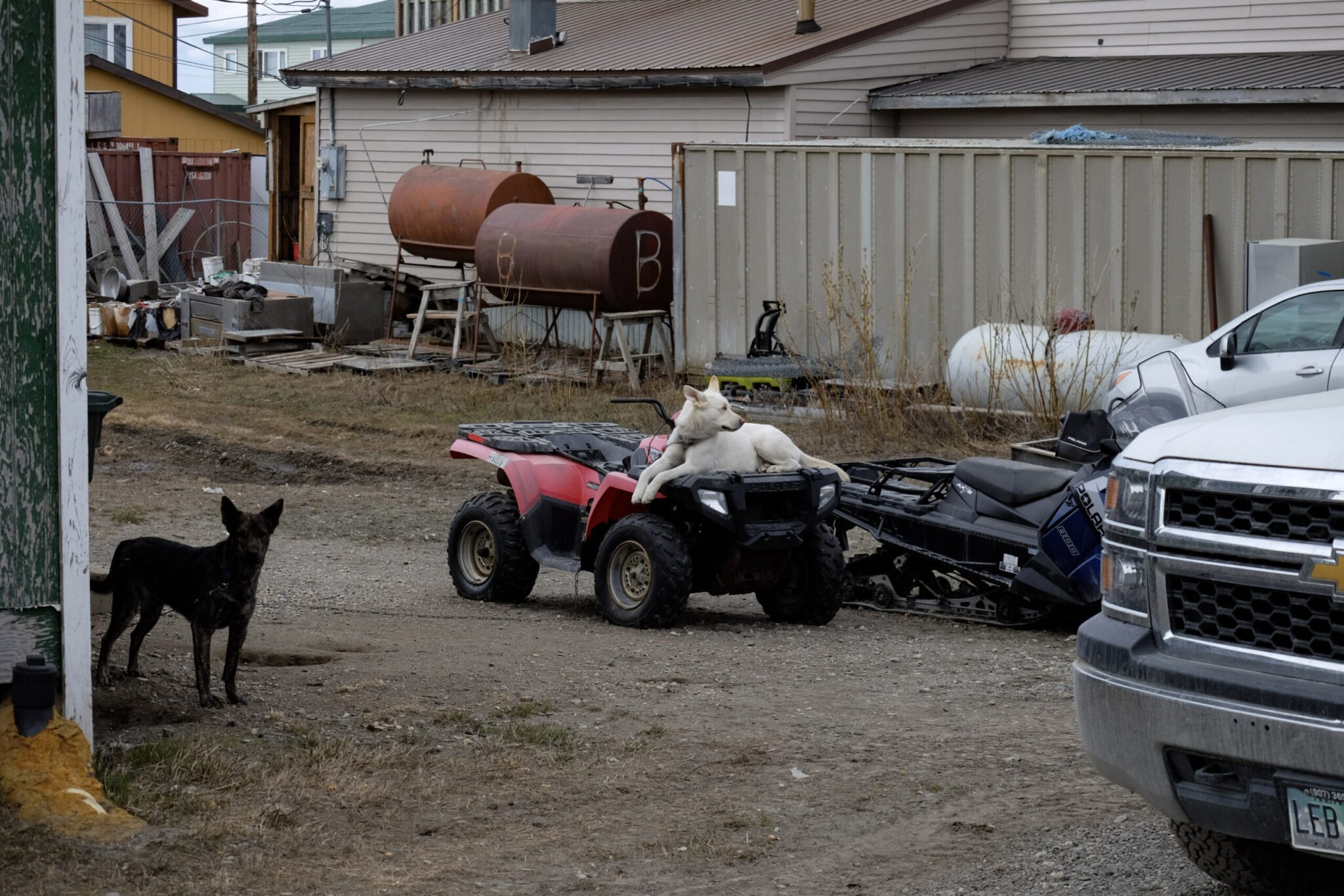
Photos by Lazo Gitchos
A hard rain rips at my tent. It sounds like Velcro. It’s hot inside but my feet are cold. The summer days are impossibly long between white Arctic nights. The wind blows like the sky has been slashed open and is deflating, filling the wet emptiness below with more air than it can hold. In a place already scoured there is nowhere to hide from the wind, and the rain falls out of the bottom of thick fog. It feels as if my clothes may never dry. The flowers on the grass airstrip are saturated purple. There are more than yesterday. The tundra is “greening up,” cottongrass blooming little white poofs in their flattened, ancient toupees of dead plant matter. Some tussocks are tall, 18 inches or more, and the buds on shrubby willows are just now shooting. It’s late June and I am in Alaska’s Brooks Range, counting birds.
On survey, I look down to avoid crushing the pink and blue and purple flowers, or else I look across the valley at the mountains colored by the clouds on the horizon; Jeremy looks down at the GPS, or else at the bushes for birds. He identifies the species by song. I record it on a clipboard. He told me the birdsongs we heard from golden-crowned sparrows might be unrecognizable from members of the same species a few hundred miles south. They have regional dialects, accents, he says. These birds are song-learners: they pick up their song from adults of the same species when they are young. Geographically separate populations, if apart long enough, sing different songs.
—

I ate dinner with John A. Nash in Fairbanks in late May, a few days before we went into the field. We were both on our way north to look at birds; John to Utqiakvik, Alaska (the northernmost town in the United States) to study nesting shorebirds, I to a field camp in Noatak National Preserve to count migratory songbirds. I was headed to Noatak to ask questions about bird science, John to answer them. He reminded me to keep an eye out for the gray-headed chickadee, presumed locally extinct in the Western Hemisphere but last sighted in Noatak in 2016.
Since last summer John has, like me, returned to Yale for his senior year. He co-published a paper in the International Journal of Avian Science with other ornithologists including Richard Prum, author of The Evolution of Beauty, presenting evidence that a pigeon collected on Negros Island in the Philippines in 1953 constitutes its own unique species: Ptilinopus arcanus, the Negros Fruit Dove. John and four other scientists gathered this evidence through analysis of DNA collected from the toe pads of the preserved bird, the only known sighting of the species, which is held at the Peabody Museum.
John, the sweetheart of Yale’s ornithology department (due in equal parts to his outsized contributions to the field as an undergraduate and his epic mullet), says that one of the most important debates in genomic analysis right now surrounds the species as a base unit of taxonomic analysis. The most widely shared definition, called the biological species concept, holds that two organisms belong to the same species if they can reproduce viable offspring. But John says that definition doesn’t account for species like the Brewster’s warbler which, though morphologically distinct from its two parent species, the golden-winged and blue-winged warblers, can breed back into either of its parent species, and is also viable on its own or with another variation known as the Lawrence’s warbler.Biologists, including ornithologists, have a hard time agreeing on what constitutes a species; reproductive isolation, geographic isolation, morphology, and behavior are all individually insufficient to differentiate species.
Physical characteristics can diverge very quickly within the same species in response to changes in environment, remain very similar in isolated populations without species divergence, or even converge from distant evolutionary paths based on evolutionarily-conserved structures. The February 19, 2024, New York Times article “What Is A Species, Anyway?” addressed the discordant ideas in the field. Newer biological inquiry, John said, increasingly focuses on the subspecies because less is known about the finer distinctions. “A bogeyman in evolutionary science is defining ‘what exactly is a species?’… there’s not necessarily agreement over what that threshold of difference is.”
—

The airstrip, where we were dropped off and made our camp, showed off a smattering of purple flowers which had cropped up on the stems of the low rhododendrons. They were delicate and thin-petaled with woody sprawling stems. They made the place feel less hostile to life, but the stems only escape the incessant grazing of Caribou because the leaves are toxic. The rhododendron family is an empire of species, its thousand-plus members extending across much of the arable land in the world. Here they are low and crawling, punctuating gray-green grasses. Labrador tea, an aromatic shrub in the rhododendron family, is common.
The process of classification by which all rhododendrons have come to be associated under one genus isn’t particularly recent; taxonomy as we know it has been around since 1735, when Carl Linnaeus articulated the binomial latinate naming system which we still use. Taxonomy, for plants and animals, relies on the observation of physical characteristics and behavior, properties of reproduction, and similarities in the structures of organisms. For hundreds of years, taxonomy was the best available scientific tool for classifying organisms in the natural world. But recently, with the introduction of genetic analysis, a new field of classification has emerged. Genomics, which seeks to track the evolutionary origin of organisms through DNA, often aligns with taxonomy and has been incorporated into the existing categorization system. While taxonomy was about understanding the natural world, genomics seeks to advance our understanding of evolutionary history.
Compared to taxonomy, genetic analysis aims at a deeper, clearer understanding of the natural world—“evolutionary history is not necessarily the accumulation of externally perceptible differences,” John told me. Genomics can help expose evolutionary history that may not present itself to the human eye. Still, John reminds me, “there’s no such thing as a perfect [phylogenetic] tree.” All the best analyses rely on assumptions and inferences, including the level of difference at which a group of organisms qualifies as a new species, and the level—species or something smaller—at which the organism is worth studying. These are human decisions, subject to incomplete understanding.
—

In Alaska, Jeremy, Jared (a field technician) and I start the count before 3 a.m. To the north, the sun is still sinking towards a high ridge, boiling in the clouds over the continental divide. As the morning gets on, the temperature drops. The light does not change. By 3:15 the process slows, reverses, and the sun imperceptibly begins to rise. It is always cloudy over that ridge to the north, so it does not warm until nearly 6 a.m., by which time the survey is nearly half done. We walk back to camp as the sun climbs the hill to the west, away from the notch to the north that marks solar midnight. When the surveying day is done, Jared’s eyes stay glued to his binoculars, hoping in vain for a little gray-headed flash in the shrubs.
Jared told me that his dream vacation is to go to Argentina and look at Pumas. Pumas, he said, are the same as mountain lions, which are the same as cougars, and they have the widest geographic range of any terrestrial mammal in the western hemisphere. Linnaeus, our original taxonomist, creatively called it Felis Concolor, which means ‘uniformly-colored cat.’ It holds the world record for most names given to a single species, at over 40. Early genetic analysis in the ‘80s discouraged the idea that there were multiple species, but divided the existing population into six geographically-defined subspecies, including the Florida panther (which is not a member of Panthera).
But genetic testing has advanced a lot in the last few decades. “If you did [additional] genetic testing,” Jared said, “you might find that the ones in Argentina are different enough from the ones in North Carolina which are different enough from the ones in British Columbia to be considered multiple species. But for now, we’re in a beautiful moment where they’re all one species in a huge diversity of ecosystems and climates.”
—

On a ridge up the valley from camp, past the 1982 US Geological Survey marker, there is a midden of rusting steel barrels painted army green. They predate the survey marker and the National Preserve designation. And, because they were discarded more than 50 years ago, there is no imperative to remove them. Such is the rule on federal land: if it’s been there long enough, it’s a part of the landscape. So, the trashed fuel barrels of a bygone petroleum prospecting expedition have joined the caribou skulls, willow shrubs, and marine fossils as federal property. Dave Swanson, a soil and vegetation ecologist with the Park Service who joined for a part of the survey expedition, was born around the time the barrels were emptied and tossed. “I better retire soon,” he told me, “before there’s litter from my early career that I’m not allowed to pick up.”
Land conservation designations are as impactful, and as human-delineated, as the fine grained species questions. Both make subjective, relational experience more concrete and universal. “Phylogeny always has a purpose… especially as the Tree of Life [the evolutionary history of all organisms on Earth] gets worked out, there wouldn’t necessarily be a reason to just keep sequencing,” John said. But we’re still at a point in our understanding of phylogeny that finer and finer analysis is useful to biologists.
A plant that was common near our camp has recently been reclassified as a kind of rhododendron, or else is no longer considered a kind of rhododendron, I can’t remember. Nothing about the plant changed in the process. It happens with birds, too. Some of the birds we saw may be genetically distinct enough from other, more southern populations to be distinguished at the species level. But without thorough genetic testing, it’s moot. According to current scientific classification, the Siberian tit and the grey-headed chickadee are both subspecies of Poecile cinctus. But in Alaska, the grey-headed chickadee is presumed extinct, while the Siberian tit is still common in Europe, which via the Bering Strait is not all that far. Depending on other thresholds for genetic distinction, the two might be independent at the species level. If so, the grey-headed chickadee would likely be treated far differently.
—

The morning we flew out, it was calm and sunny, and the pilot brought a bigger plane to get us in one trip, rather than the three it took to drop us off. It was his first time landing the 1953 De Havilland Otter on the grass Kelly Bench strip. We loaded gear and steel food barrels, tubs of data sheets and finally ourselves. We plugged our helmet headsets into the overhead jacks. The pilot taxied down to the end of the bench, the plane canted up toward the sky, its tail dragging on its wheel. We sat a moment. The pilot reached down for the throttle and we began to move. The wind was ahead, blowing down the Kelly River valley and across the bench and under the Otter’s wings. The throttle and the wind were barely enough. We neared the end of the strip. The bluff approached, and the pilot pulled the throttle forward, and forward. The plane pitched forward as the rear wheel lifted, and we saw that we were approaching the edge. The bumping lessened then ceased and the wheels left the ground. The pilot’s voice fuzzed over the headsets: “looks like we had about 25 feet.” He laughed. The Anchorage airport, 600 miles south, is named for Ted Stevens, an Alaska senator who died in a plane crash, in the same kind of plane.
In three weeks we had seen 50 kinds of birds. Golden plovers, jaegers, and whimbrels made nests on the tundra near our camp. Harriers dive bombed us, defending their nests. We saw short-eared owls and rough-legged hawks hunting for lemming in the little trenches the rodents make by their constant running. We counted sparrows and warblers and bluethroats and other singing birds in the shrubby creek bottoms and on the barren ridges. We saw bears and caribou and a porcupine; we didn’t see the gray-headed chickadee.







